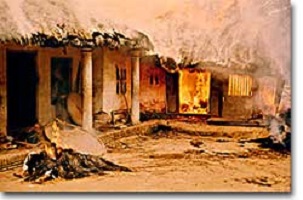55e. Years of Withdrawal

The unspeakable horror of the 1968 My Lai massacre was not revealed to the American public until investigative journalist Seymour Hersh published his findings in November, 1969. According to troops who either witnessed or took part in the massacre, orders had been given "to destroy My Lai and everything in it." Over 300 civilians were killed and the village itself was burned to the ground.
President Nixon had a plan to end American involvement in Vietnam.
By the time he entered the White House in 1969, he knew the American war effort was failing. Greater military power may have brought a favorable outcome, but there were no guarantees. And the American people were less and less willing to support any sort of escalation with each passing day.
Immediate American withdrawal would amount to a defeat of the noncommunist South Vietnamese allies. Nixon announced a plan later known as Vietnamization. The United States would gradually withdraw troops from Southeast Asia as American military personnel turned more and more of the fighting over to the Army of the Republic of Vietnam. In theory, as the South Vietnamese became more able to defend themselves, United States soldiers could go home without a communist takeover of Saigon.
Troop withdrawals did little to placate the antiwar movement. Demonstrators wanted an immediate and complete departure. Events in Vietnam and at home gave greater strength to the protesters.
In the spring of 1970, President Nixon announced a temporary invasion of neighboring Cambodia. Although Cambodia was technically neutral, the Ho Chi Minh trail stretched through its territory. Nixon ordered the Viet Cong bases located along the trail to be bombed.
Kent State and My Lai Massacres
Peace advocates were enraged. They claimed that Nixon was expanding the war, not reducing it as promised. Protests were mounted across America.
At Kent State University, students rioted in protest. The burned down the ROTC building located on campus, and destroyed local property. The governor of Ohio sent the National Guard to maintain order. A state of high tension and confusion hung between the Guard and the students. Several soldiers fired their rifles, leading to deaths of four students and the wounding of several others. This became known as the Kent State massacre.

This B-52 bomber in the background of this photo — downed during bombing in 1968 — sits in a small pond in Hanoi. Busy markets surround the fallen plane and the site has become a popular tourist destination.
The following year the American public learned about the My Lai massacre. In 1968, American soldiers opened fire on several hundred women and children in the tiny hamlet of My Lai. How could this happen? It was not unusual for Viet Cong guerilla activity to be initiated from small villages. Further, U.S. troops were tired, scared, and confused.
At first the Lieutenant who had given the order, William L. Calley, Jr., was declared guilty of murder, but the ruling was later overturned. Moral outrage swept through the antiwar movement. They cited My Lai as an example of how American soldiers were killing innocent peasants.
The Pentagon Papers
In 1971, the New York Times published excerpts from the Pentagon Papers, a top-secret overview of the history of government involvement in Vietnam. A participant in the study named Daniel Ellsberg believed the American public needed to know some of the secrets, so he leaked information to the press. The Pentagon Papers revealed a high-level deception of the American public by the Johnson Administration.

The North Vietnamese Army captured Saigon in April, 1975, and renamed the capital Ho Chi Minh City. It was at this time that the last remaining American personnel in Vietnam were forced to flee.
Many statements released about the military situation in Vietnam were simply untrue, including the possibility that even the bombing of American naval boats in the Gulf of Tonkin might never have happened. A growing credibility gap between the truth and what the government said was true caused many Americans to grow even more cynical about the war.
By December 1972, Nixon decided to escalate the bombing of North Vietnamese cities, including Hanoi. He hoped this initiative would push North Vietnam to the peace table. In January 1973, a ceasefire was reached, and the remaining American combat troops were withdrawn. Nixon called the agreement "peace with honor," but he knew the South Vietnamese Army would have difficulty maintaining control.
The North soon attacked the South and in April 1975 they captured Saigon. Vietnam was united into one communist nation. Saigon was renamed Ho Chi Minh City. Cambodia and Laos soon followed with communist regimes of their own. The United States was finally out of Vietnam. But every single one of its political objectives for the region met with failure.
Over 55,000 Americans perished fighting the Vietnam War.





